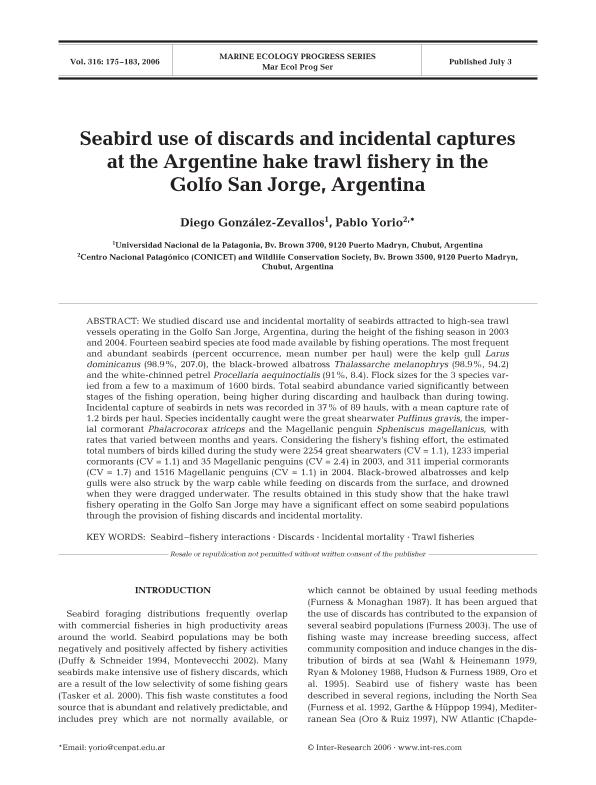Mostrar el registro sencillo del ítem
dc.contributor.author
Gonzalez Zevallos, Diego Ricardo

dc.contributor.author
Yorio, Pablo Martin

dc.date.available
2017-05-19T19:54:33Z
dc.date.issued
2006-07-03
dc.identifier.citation
Gonzalez Zevallos, Diego Ricardo; Yorio, Pablo Martin; Seabird use of discards and incidental captures at the Argentine hake trawl fishery in the Golfo San Jorge, Argentina; Inter-research; Marine Ecology Progress Series; 316; 3-7-2006; 175-183
dc.identifier.issn
0171-8630
dc.identifier.uri
http://hdl.handle.net/11336/16764
dc.description.abstract
We studied discard use and incidental mortality of seabirds attracted to high-sea trawl vessels operating in the Golfo San Jorge, Argentina, during the height of the fishing season in 2003 and 2004. Fourteen seabird species ate food made available by fishing operations. The most frequent and abundant seabirds (percent occurrence, mean number per haul) were the kelp gull Larus dominicanus (98.9%, 207.0), the black-browed albatross Thalassarche melanophrys (98.9%, 94.2) and the white-chinned petrel Procellaria aequinoctialis (91%, 8.4). Flock sizes for the 3 species var- ied from a few to a maximum of 1600 birds. Total seabird abundance varied significantly between stages of the fishing operation, being higher during discarding and haulback than during towing. Incidental capture of seabirds in nets was recorded in 37% of 89 hauls, with a mean capture rate of 1.2 birds per haul. Species incidentally caught were the great shearwater Puffinus gravis , the imper- ial cormorant Phalacrocorax atriceps and the Magellanic penguin Spheniscus magellanicus , with rates that varied between months and years. Considering the fishery’s fishing effort, the estimated total numbers of birds killed during the study were 2254 great shearwaters (CV = 1.1), 1233 imperial cormorants (CV = 1.1) and 35 Magellanic penguins (CV = 2.4) in 2003, and 311 imperial cormorants (CV = 1.7) and 1516 Magellanic penguins (CV = 1.1) in 2004. Black-browed albatrosses and kelp gulls were also struck by the warp cable while feeding on discards from the surface, and drowned when they were dragged underwater. The results obtained in this study show that the hake trawl fishery operating in the Golfo San Jorge may have a significant effect on some seabird populations through the provision of fishing discards and incidental mortality.
dc.format
application/pdf
dc.language.iso
eng
dc.publisher
Inter-research

dc.rights
info:eu-repo/semantics/openAccess
dc.rights.uri
https://creativecommons.org/licenses/by-nc-sa/2.5/ar/
dc.subject
Seabird-Fishery Interactions
dc.subject
Discards
dc.subject
Incidental Mortality
dc.subject
Trawl Fisheries
dc.subject.classification
Ecología

dc.subject.classification
Ciencias Biológicas

dc.subject.classification
CIENCIAS NATURALES Y EXACTAS

dc.title
Seabird use of discards and incidental captures at the Argentine hake trawl fishery in the Golfo San Jorge, Argentina
dc.type
info:eu-repo/semantics/article
dc.type
info:ar-repo/semantics/artículo
dc.type
info:eu-repo/semantics/publishedVersion
dc.date.updated
2017-05-17T13:52:27Z
dc.journal.volume
316
dc.journal.pagination
175-183
dc.journal.pais
Alemania

dc.journal.ciudad
Oldendorf
dc.description.fil
Fil: Gonzalez Zevallos, Diego Ricardo. Consejo Nacional de Investigaciones Científicas y Técnicas. Centro Nacional Patagónico; Argentina. Universidad Nacional de la Patagonia; Argentina
dc.description.fil
Fil: Yorio, Pablo Martin. Consejo Nacional de Investigaciones Científicas y Técnicas. Centro Nacional Patagónico; Argentina
dc.journal.title
Marine Ecology Progress Series

dc.relation.alternativeid
info:eu-repo/semantics/altIdentifier/url/http://www.int-res.com/abstracts/meps/v316/p175-183/
Archivos asociados
